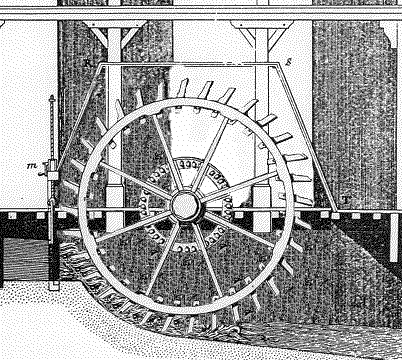Hydro Power China
When it rains in hills and mountains, the water becomes streams and rivers that run down to the ocean. The moving or falling water can be used to do work. Energy, you’ll remember is the ability to do work. So moving water, which has kinetic energy, can be used to make electricity.
For hundreds of years, moving water was used to turn wooden wheels that were attached to grinding wheels to grind (or mill) flour or corn. These were called grist mills or water mills.
In the year 1086, the Domesday Book was written. The multi-volume books are very large. Hand-written on the pages of the books are lists of all properties, homes, stores and other things in England. The Doomsday Book listed 5,624 waterwheel-driven mills in England south of the Trent River. That was about one mill for each 400 people.

Water can either go over the top of the wheel like in the photograph on the left, or the wheel can be placed in the moving river. The flow of the river then turns the wheel at the bottom like in the moving graphic on the right.
Today, moving water can also be used to make electricity.
Hydro means water. Hydro-electric means making electricity from water power.
Hydroelectric power uses the kinetic energy of moving water to make electricity. Dams can be built to stop the flow of a river. Water behind a dam often forms a reservoir Like the picture of Shasta Dam in Northern California pictured on the right. Dams are also built across larger rivers but no reservoir is made. The river is simply sent through a hydroelectric power plant or powerhouse. You can see this in the picture of The Dalles Dam on the Columbia River along the border of Oregon and Washington State.
Hydro is one of the largest producers of electricity in the United States. Water power supplies about 10 percent of the entire electricity that we use. In states with high mountains and lots of rivers, even more electricity if made by hydro power. In California, for example, about 15 percent of all the electricity comes from hydroelectric.
The state of Washington leads the nation in hydroelectricity. The Grand Coulee, Chief Joseph and John Day dams are three of six major dams on the Columbia River. About 87 percent of the electricity made in Washington state is produced by hydroelectric facilities. Some of that electricity is exported from the state and used in other states.
How a Hydro Dam Works
The water behind the dam flows through the intake and into a pipe called a penstock. The water pushes against blades in a turbine, causing them to turn. The turbine is similar to the kind used in a power plant that we learned about .But instead of using steam to turn the turbine, water is used.
The turbine spins a generator to produce electricity. The electricity can then travel over long distance electric lines to your home, to your school, to factories and businesses.
Hydro power today can be found in the mountainous areas of states where there are lakes and reservoirs and along rivers.


